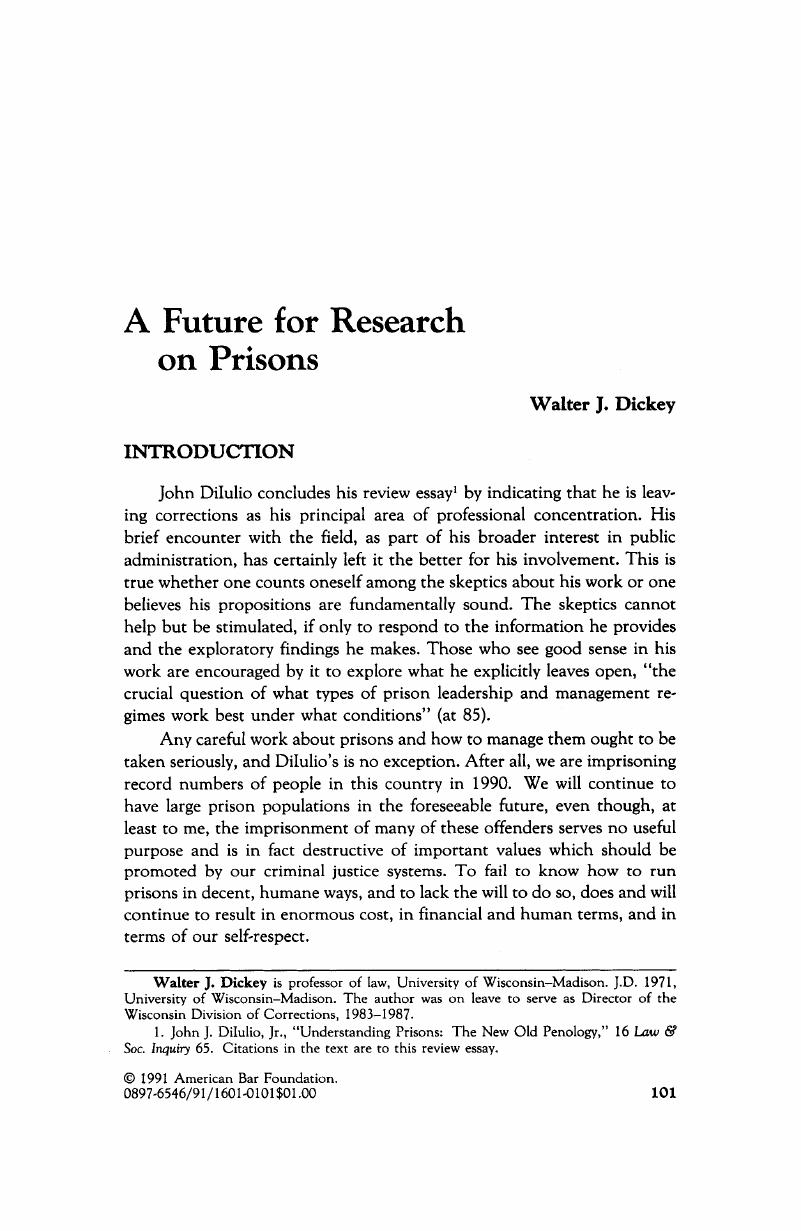No CrossRef data available.
Article contents
A Future for Research on Prisons
Published online by Cambridge University Press: 27 December 2018
Abstract

- Type
- Review Essay
- Information
- Copyright
- Copyright © American Bar Foundation, 1991
References
1 John, J. DiIulio Jr., “Understanding Prisons: The New Old Penology,” 16 Law & Soc. Inquiry 65. Citations in the text are to this review essay.Google Scholar
2 John J. DiIulio, Jr., Governing Prisons: A Comparative Study of Correctional Management (New York: Free Press, 1987).Google Scholar
3 DiIulio's discussion of the “new penology” at 72–80.Google Scholar
4 John, Irwin, “Donald Cressey and the Sociology of the Prison,” Crime & Delinquency 335 (1988).Google Scholar
5 The issue of whether American correctional institutions should punish or rehabilitate offenders has been intensely debated, most recently since the mid-1970s. In 1975, Ernest van den Haag argued that punishment is necessary to denounce wrongdoers and to confirm the social solidarity of law-abiding citizens. Van den Haag, Punishing Criminals (New York: Basic Books, 1975). A year later Andrew von Hirsch, in Doing Justice (New York: Hill & Wang, 1976), and Alan Dershowitz, in the Twentieth Century Fund's Fair and Certain Punishment (New York: McGraw-Hill, 1976), attacked the indeterminate sentences which were part of the rehabilitative package. Indeed, von Hirsch flatly asserted that in those cases where no successful treatments for offenders are known—most cases—“the rehabilitative disposition is plainly untenable.”Doing Justice at 18.Google Scholar
By the mid-1980s, the policy statement of the United States Sentencing Commission indicated the extent to which punishment had replaced rehabilitation as the goal of criminal sentencing. The commission asserted that the proper goals of sentencing were honesty, uniformity, and proportionality (that is, proportionality to the seriousness of the offense); rehabilitation was specifically excluded as a goal. United States Sentencing Commission, Sentencing Guidelines and Policy Statements (Washington, D.C.: Government Printing Office, April 13, 1987), and Supplementary Report on the. Initial Sentencing Guidelines and Policy Statements (Washington, D.C.: Government Printing Office, June 18, 1987). By 1990, the dominant model for corrections has become the “just deserts”/punishment model advocated by von Hirsch and embodied in the federal sentencing guidelines. A useful discussion of the various—and often conflicting—goals of sentencing appears in Hyman Gross & Andrew von Hirsch, eds., Sentencing (New York: Oxford University Press, 1981).Google Scholar
6 In 1984, Lawrence W. Sherman and Richard A. Berk published the results of a Minneapolis study which, the authors asserted, indicated that arresting domestic violence offenders lowered the number of new offenses. See Lawrence, W. Sherman &. Richard, A. Berk, “The Specific Deterrent Effects of Arrest for Domestic Assault, 49 Am. Soc. Rev. 261 (1984), and The Minneapolis Domestic Violence Experiment (Washington, D.C.: Police Foundation, 1984). Once the Minneapolis experiment was publicized, the idea of mandatory arrest for domestic violence offenses became politically popular, influencing both legislatures and police agencies. In Wisconsin, for example, a “mandatory arrest” bill was passed by the state legislature (Wis. Act 346 (1987)). Moreover, over one-third of the respondents from police departments in 117 American cities surveyed by Sherman and Ellen Cohn stated that their policies on domestic violence have been influenced by the Minneapolis experiment. Lawrence, W. Sherman & Ellen, G. Cohn, “The Impact of Research on Legal Policy: The Minneapolis Domestic Violence Experiment,” 23 Law & Soc'y Rev. 117 (1989). Richard Lempert has argued that the Minneapolis experiment was publicized too early, before its results could be replicated; that the results themselves are doubtful; and that the experiment has had undue influence on American legal policy making. Richard, O. Lempert, “From the Editor,” 18 Law & Soc'y Rev. 505 (1984, and “Humility Is a Virtue; On the Politization of Policy-relevant Research,” 23 Law & Soc'y Rev. 145 (1989).Google Scholar
7 See Walter J. Dickey, “From the Bottom Up: Probation Supervision in a Small Wisconsin Community (Monograph, 1988); Dickey, “From the Bottom Up: The High Risk Intensive Supervision Unit” (Monograph, 1990; Dickey,” From the Bottom Up: The Fox Lake Prison (Monograph, 1990); Dickey,” From the Bottom Up: Probation and Parole Supervision in Milwaukee” (Monograph, forthcoming 1990).Google Scholar
8 1990 Wisconsin Department of Corrections statistics. In Wisconsin, then, about 81% of the individuals under correctional supervision are not in custodial institutions. The Wisconsin figure is only slightly higher than the national average: in the United States as a whole, out of 3.7 million persons under correctional supervision in 1988, over 2.76 million—or about 75%—were on probation or parole. 14 Corrections Compendium No. 8 (Nov. 1989), at 17.Google Scholar




